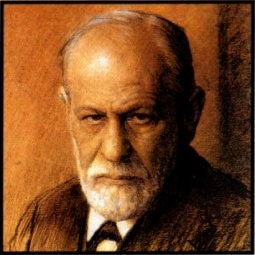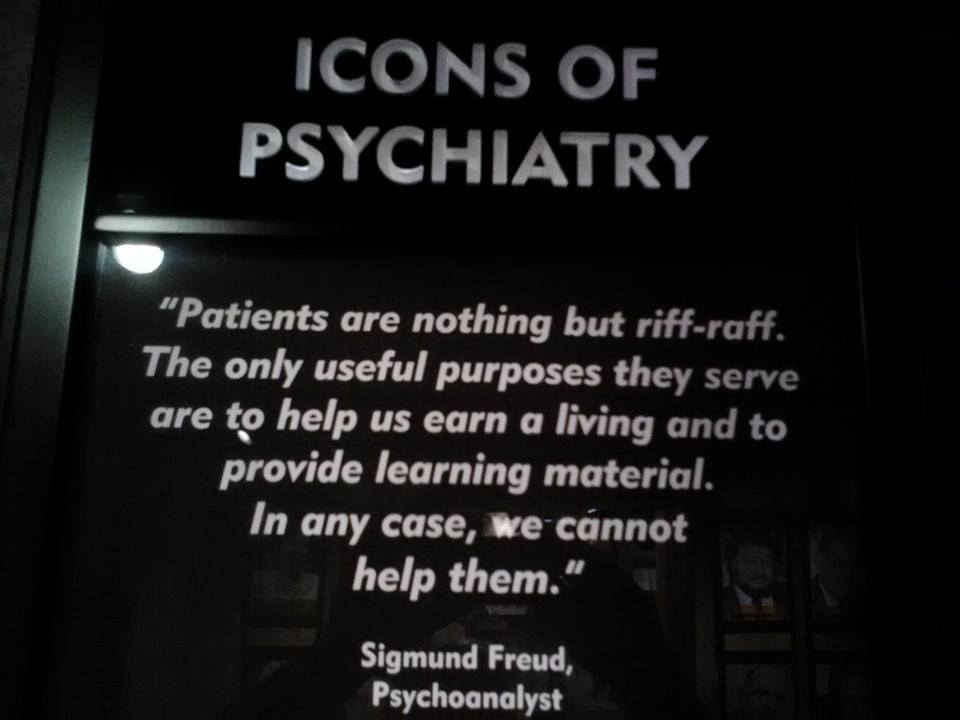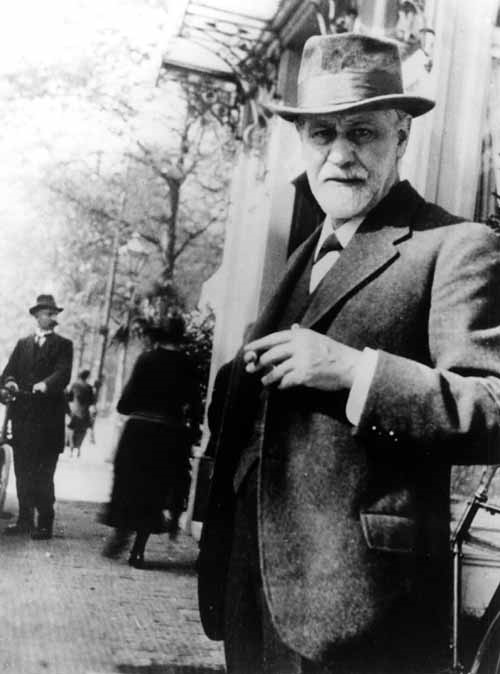
Sigmund Freud
Psychology
Ideologies
(poisonous)
Anti-Christ (Love)
''Freudian psychology was developed by the parasitic order to neutralize the incessant efforts of the host to throw off or dislodge the parasite. Any move to dislodge the parasite is denounced as “reactionary”. It is defined and outlawed as an act of aggression, hostility, and alienation. In fact, the host is merely trying to survive by throwing off the parasite. Another law of nature is that the parasite, not only by sucking off the life sustenance of the host, but also by altering its life cycle, will inevitably kill the host. This process is called “the decline and fall of civilization”. --[1984] The World Order Our Secret Ruler by Eustace Mullins
[Psychopath. Director of Tavistock Institute. Called Freud Hilton. He looks a miserable sod, rather like Pasteur. His 'therapy' has yet to cure anyone.]
[2010] Freud's Part in
Our Satanic Possession by Henry Makow Ph.D
[1997] SIGMUND FREUD: ANTICHRIST DEVIL by Eustace Mullins
Books
[2011] Freud on Coke by David Cohen
[2004] Sigmund Freud and the Jewish Mystical Tradition by David Bakan
Quotes by Freud
“Sexual morality — as society in its extreme form, the
American, defines it — is contemptible. I advocate an incomparably freer sexual
life.”---Sigmund Freud
"If only Americans knew, we are bringing them the plague!" ---Sigmund Freud
External
Sabbateans and the Golden Dawn
Anna Freud: Part 1 – ‘Her secret failure’
Jewish Involvement in the Psychoanalytic Movement
Sigmund_Freud_and_the_Lubavitcher_Rebbe.pdf
FREUD_and_Lurianic_Kabbalah.pdf


“Sexual morality is contemptible. I advocate an incomparably freer sexual life….If
only Americans knew, we are
bringing them the plague!"
Culture of Critique —The Oedipal complex as scientific fraud by Kevin MacDonald
As in the case of several Jewish movements and political activities reviewed in Chapters 2 and 3 (see also SAID, Ch. 6), Freud took great pains to ensure that a gentile, Jung, would be the head of his psychoanalytic movement—a move that infuriated his Jewish colleagues in Vienna, but one that was clearly intended to deemphasize the very large overrepresentation of Jews in the movement during this period. To persuade his Jewish colleagues of the need for Jung to head the society, he argued, “Most of you are Jews, and therefore you are incompetent to win friends for the new teaching. Jews must be content with the modest role of preparing the ground. It is absolutely essential that I should form ties in the world of science” (in Gay 1988, 218). As Yerushalmi (1991, 41) notes, “To put it very crudely, Freud needed a goy, and not just any goy but one of genuine intellectual stature and influence.” Later, when the movement was reconstituted after World War I, another gentile, the sycophantic and submissive Ernest Jones, became president of the International Psychoanalytic Association.
The cure for the aggression characteristic of anti-Semitism was therefore
believed to lie in freeing gentiles from their sexual repressions. Although
Freud himself eventually developed the idea of a death instinct to explain
aggression, a consistent theme of the Freudian critique of Western culture, as
exemplified for example by Norman O. Brown, Herbert Marcuse, and Wilhelm Reich,
has been that the liberation of sexual repressions would lead to lowered
aggression and usher in an era of universal love.
It is therefore of interest that when Jung and Alfred Adler were expelled from
the movement for heresy, the issue that appears to have been most important to
Freud was their rejection of the interrelated ideas of the sexual etiology of
neurosis, the Oedipal complex, and childhood sexuality.
This belief in the curative powers of sexual freedom coincided with a leftist
political agenda common to the vast majority of Jewish intellectuals of the
period and reviewed throughout this book. This leftist political agenda proved
to be a recurrent theme throughout the history of psychoanalysis. Support of
radical and Marxist ideals was common among Freud’s early followers, and leftist
attitudes were common in later years among psychoanalysts (Hale 1995, 31;
Kurzweil 1989, 36, 46-47, 284; Torrey 1992, 33, 93ff, 122-123), as well as in
Freudian inspired offshoots such as Erich Fromm, Wilhelm Reich (see below) and
Alfred Adler. (Kurzweil [1989, 287] terms Adler the leader of “far left”
psychoanalysis, noting that Adler wanted to immediately politicize teachers as
radicals rather than wait for the perfection of psychoanalysis to do so.) The
apex of the association between Marxism and psychoanalysis came in the 1920s in
the Soviet Union, where all the top psychoanalysts were Bolsheviks, Trotsky
supporters, and among the most powerful political figures in the country (see
Chamberlain 1995). (Trotsky himself was an ardent enthusiast of psychoanalysis.)
This group organized a government-sponsored State Psychoanalytical Institute and
developed a program of “pedology” aimed at producing the “new Soviet man” on the
basis of psychoanalytic principles applied to the education of children. The
program, which encouraged sexual precocity in children, was put into practice in
state-run schools.
Excerpts from Kevin MacDonald - Culture of
Critique, pages 110-111
"Interestingly, although recent scholarship is unanimous that Freud had an
intense Jewish identity, Freud took pains to conceal this identity from others
because of a concern that his psychoanalytic movement would be viewed as a
specifically Jewish movement and thus be the focus of anti-Semitism. Whereas his
private correspondence is filled with a strong sense of Jewish ethnic identity,
his public statements and writings exhibited a “generally guarded, distanced
tone” (Yerushalmi 1991, 42), indicating an effort at deception. Freud also
attempted to downplay in public the extent to which Judaism pervaded his family"
"Deception is also indicated by the evidence that Freud felt that one reason
psychoanalysis needed highly visible gentiles was because he viewed
psychoanalysis as subverting gentile culture. After publishing Little Hans in
1908, he wrote to Karl Abraham that the book would create an uproar: “German
ideals threatened again! Our Aryan comrades are
really completely indispensable to us, otherwise psychoanalysis would succumb to
anti-Semitism” (in Yerushalmi 1991, 43).
"Many early proponents viewed psychoanalysis as a redemptive messianic movement
that would end anti-Semitism by freeing the world of neuroses produced by
sexually repressive Western civilization. Klein shows that some of Freud’s
closest associates had a very clearly articulated conception of
psychoanalysis as a Jewish mission to the
gentiles—what one might view as a uniquely modern version of the ancient “light
of the nations” theme of Jewish religious thought very common among
intellectual apologists of Reform Judaism during the same period."
"Thus for Otto Rank, who developed a close father-son relationship with Freud,
Jews were uniquely qualified to cure neurosis and act as the healers of humanity
(Klein 1981, 129). Developing a variant of the perspective Freud used in Totem
and Taboo and Civilization and Its Discontents, Rank argued that whereas other
human cultures had repressed their primitive sexuality in the ascent to
civilization, “Jews possessed special creative powers since they had been able
to maintain a direct relation to ‘nature,’ to primitive sexuality” (Klein 1981,
129).97 Within this perspective, anti-Semitism
results from the denial of sexuality, and the role of the Jewish mission of
psychoanalysis was to end anti- Semitism by freeing humanity of its sexual
repressions. A theoretical basis for this perspective was provided by
Freud’s Three Essays on the Theory of Sexuality, in which aggression was linked
with the frustration of drives.
The Oedipal
complex as scientific fraud
The theory of the Oedipal complex, childhood sexuality, and the
sexual etiology of the neuroses—the three central doctrines that underlie
Freud’s radical critique of gentile culture—play absolutely no role in
contemporary mainstream developmental psychology. From the standpoint of
evolutionary theory, the idea that children would have a specifically sexual
attraction to their opposite sex parent is highly implausible, since such an
incestuous relationship would result in inbreeding depression and be more likely
to result in disorders caused by recessive genes (see MacDonald 1986). The
proposal that boys desire to kill their fathers conflicts with the general
importance of paternal provisioning of resources in understanding the evolution
of the family (MacDonald 1988a; 1992): Boys who had succeeded in killing their
fathers and having sex with their mothers would not only be left with
genetically inferior offspring, but also be deprived of paternal support and
protection. Modern developmental studies indicate that many fathers and sons
have very close, reciprocated affectional relationships beginning in infancy,
and the normative pattern is for mothers and sons to have very intimate and
affectionate, but decidedly nonsexual, relationships.
The continued life of these concepts in psychoanalytic circles is testimony to
the continuing unscientific nature of the entire enterprise. Indeed, Kurzweil
(1989, 89) notes “In the beginning, the Freudians tried to ‘prove’ the
universality of the Oedipus complex; later on, they took it for granted.
Ultimately, they no longer spelled out the reasons for the pervasiveness of
childhood sexuality and its consequences in the cultural monographs: they all
accepted it.”103 What started out as a speculation in need of empirical support
ended up as a fundamental a priori assumption.
Research inspired by these basic Freudian tenets ceased long ago and in a sense
never started: Fundamentally, psychoanalysis has not inspired any significant
research on these three basic Freudian constructs. Interestingly, there is
evidence that Freud fraudulently portrayed the data underlying these concepts.
Esterson (1992, 25ff; see also Crews 1994) convincingly argues that Freud’s
patients did not volunteer any information on seduction or primal scenes at all.
The seduction stories that provide the empirical basis of the Oedipal complex
were a construction by Freud, who then interpreted his patients’ distress on
hearing his constructions as proof of the theory. Freud then engaged in
deception to obscure the fact that his patients’ stories were reconstructions
and interpretations based on an a priori theory. Freud also retroactively
changed the identity of the fancied seducers from nonfamily members (such as
servants) because the Oedipal story required fathers. Esterson provides numerous
other examples of deception (and self-deception) and notes that they were
typically couched in Freud’s brilliant and highly convincing rhetorical style.
Both Esterson (1992) and Lakoff and Coyne (1993, 83-86) show that Freud’s famous
analysis of the teenage Dora (in which her rejection of the pedophilic sexual
advances of an older married man is attributed to hysteria and sexual
repression) was based entirely on preconceived ideas and circular reasoning in
which the patient’s negative emotional response to the psychoanalytic hypothesis
is construed as evidence for the hypothesis. Freud engaged in similar deceptive
reconstructions in an earlier phase of his theory construction when he believed
that seductions had actually occurred (Powell & Boer 1994). It was a methodology
that could produce any desired result.
A particularly egregious tendency is to interpret patient resistance and
distress as an indication of the truth of psychoanalytic claims. Of course,
patients were not the only ones who resisted psychoanalysis, and all other forms
of resistance were similarly an indication of the truth of psychoanalysis. As
Freud himself noted, “I am met with hostility and live in such isolation that
one must suppose I had discovered the greatest truths” (in Bonaparte, Freud &
Kris 1957, 163). As we shall see, resistance to psychoanalytic “truth” on the
part of patients, deviating psychoanalysts, and even entire cultures was viewed
as a sure sign of the truth of psychoanalysis and the pathology of those who
resisted.
Because of this reconstructive, interpretive manner of theory construction, the
authority of the psychoanalyst became the only criterion of the truth of
psychoanalytic claims—a situation that leads quite naturally to the expectation
that the movement, in order to be successful, would necessarily be highly
authoritarian. As indicated below, the movement was authoritarian from the
beginning and has remained so throughout its history.
Notice that the interpretive, hermeneutic basis of theory construction in
psychoanalysis is formally identical to the procedures of Talmudic and Midrashic
commentaries on scripture (Hartung 1995; see PTSDA, Ch. 7). Psychoanalysts have
tended to suppose that consistency with observable facts is an adequate
criterion for a scientifically acceptable causal explanation. Psychoanalysts
“inhabit a kind of scientific preschool in which no one divulges the grown-up
secret that successful causal explanation must be differential, establishing the
superiority of a given hypothesis to all of its extant rivals” (Crews 1994, 40;
italics in text). As indicated in Chapter 6, the development of consensual
theories consistent with observable reality but without any scientific content
is a hallmark of twentieth-century Jewish intellectual movements.
Any theorist on the contemporary scientific scene who proposed that children are
normally sexually attracted to their opposite sex parent would be ostracized for
providing a psychological basis for supposing that children would seek such
contact. A glaring mistake that persists throughout Freud’s writings is the
systematic conflation of sexual desire and love (see MacDonald 1986): “From the
very first, in psychoanalysis, it has seemed better to speak of these love
impulses as sexual impulses” (in Wittels 1924, 141)—a comment that suggests the
self-conscious nature of this conflation as well as indicates the casual manner
in which psychoanalysts have framed their hypotheses. Indeed, Freud conflated
all types of pleasure as fundamentally different manifestations of an underlying
and unitary but infinitely transformable sexual pleasure, including the oral
gratification resulting from breast feeding, anal gratification resulting from
defecation, sexual gratification, and love. Contemporary researchers have often
proposed that affectional ties between parents and children are developmentally
important and that children actively seek these ties. However, modern theory and
data, and certainly an evolutionary approach, provide absolutely no support for
identifying affectional ties with sexual desire or with supposing that
affectional ties are sublimated or redirected sexual desire. Modern approaches
support instead a discrete systems perspective in which sexual desire and
affection (and other sources of pleasure) involve quite separate, independent
systems. From an evolutionary perspective, the powerful affectional (love)
relationships between spouses and between parents and children function as a
source of social cohesiveness whose ultimate purpose is to provide a high level
of support for children (see MacDonald 1992).
This conflation between sexual desire and love is also apparent in many of
Freud’s psychoanalytic successors, including Norman O. Brown, Wilhelm Reich, and
Herbert Marcuse, whose works are reviewed below. The common thread of these
writings is that if society could somehow rid itself of sexual repressions,
human relations could be based on love and affection. This is an extremely naive
and socially destructive viewpoint, given the current research in the field.
Psychoanalytic assertions to the contrary were never any more than speculations
in the service of waging a war on gentile culture.
